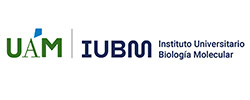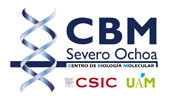Immune Development and Inflammatory-mediated Diseases
Prof. Manuel Fresno Escudero. Profesor Emérito. Departamento de Biología Molecular. UAM.
Prof. Konstantinos Stamatakis Andriani. Profesor Ayudante Doctor. Departamento de Biología Molecular. UAM.
Deletion of TCFL5, a bHLH transcription factor, drastically reduces the tumor properties of colon cancer cells. Interestingly, the 2 major isoforms, TCFL5_E1/E8 and TCFL5_E2b/E8 (CHA) had a different promoter and opposite functions, being TCFL5_E2b/E8 protumoral function. TCFL5_E1/E8 is essential for NFKB2 activity regulating the expression of anti-apoptotic genes as BCL2 whereas TCFL5_E2b/E8 controls the expression of the pluripotency markers SOX2, NANOG and KLF4. We have identified some genes regulated by TCFL5_E1/E8 and TCFL5_E2b/E8 and established its role in some leukemias and in normal lymphopoiesis. TCFL5_E2b/E8 expression was associated with greater severity in lymphoma and myeloma samples from patients. Using Tcfl5 deficient mice, we found Tcfl5 is required for the formation of germinal centers and differentiation of pro-B to pre-B cells by affecting the levels of SYK and BCR signalling, resulting in an inability to respond to stimuli and an increase in cell death. TCFL5 is also expressed during early mouse embryonic development, the preimplantation period and plays a role in the differentiation of embryonic cells to germline precursors by controlling the expression of genes important in their differentiation, as shown in Tcfl5 deficient mice.
Toll-like receptors (TLRs) play a crucial role in pathogen recognition. Howeverm signaling via TLR4 and TLR2 was different, as TLR2 ligands activated NF-κB and MAPKs earlier and exhibited a higher IL-10 /IL-12 ratio compared to TLR4 ligands. Furthermore, p38 MAPK is critical for IL-10 expression in response to TLR2 ligands, which triggers the macrophage change to a M2 and regulatory phenotype in contrast to the M1 phenotype induced by TLR4 activation. TRIF was required for IFN-β induction and consequent expression of IL-12 in response to TLR2. Moreover, in vivo administration of TLR2 ligands exert a modulatory effect on cytokines with beneficial effects on the prevention of Listeria dissemination in a murine model of neonatal listeriosis.
TLR4 is considered the major receptor to recognize all LPSs. However, some atypical LPS’s depart from the well-studied E. coli LPS and induce a TLR2-dependent inflammatory response in immune cells. Molecular docking analysis of O. intermedium LPS predicts a favorable formation of a TLR2/TLR4/MD-2 heterodimer, further confirmed by FRET. These imply that atypical LPSs may induce TLR4/TLR2 heterodimerization to decrease the bacteria activation of the innate immune system.
Finally, we were also working on Chagas’ disease caused by Trypanosoma cruzi (see N. Gironès page) and contributed to understand some immunological aspects of COVID 19 infection (see corresponding page).


